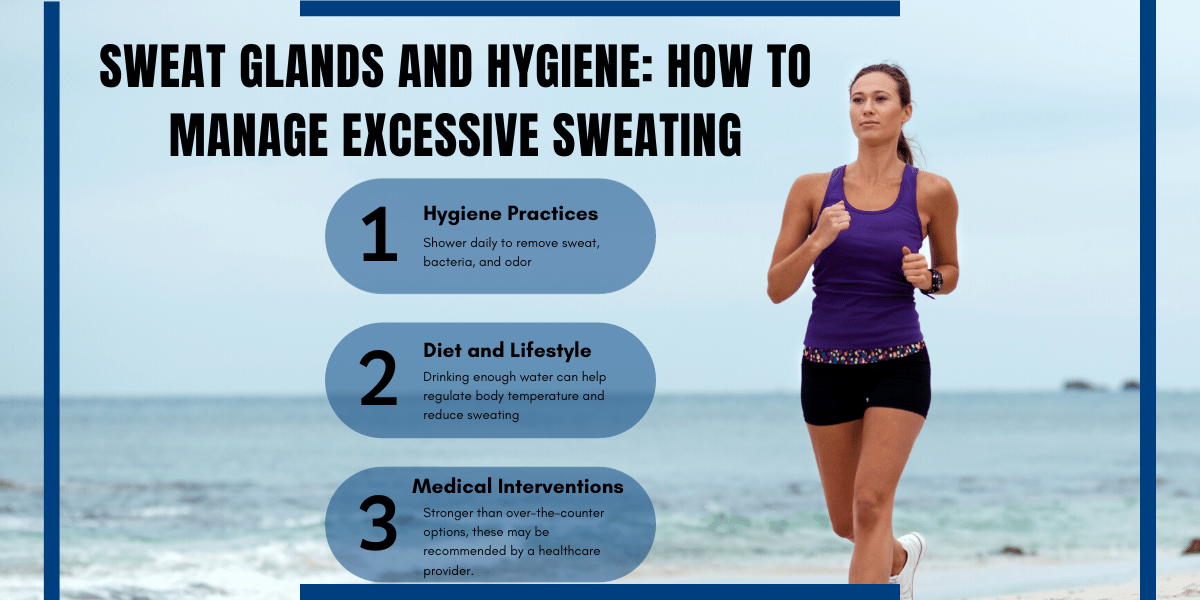Sweat Glands and Hygiene: How to Manage Excessive Sweating
Sweat Glands and Hygiene: How to Manage Excessive Sweating
Sweat No More: A Comprehensive Guide to Managing Excessive Sweating and Hygiene
Sweating is a natural and essential bodily function that helps regulate our temperature and keep us cool. However, for some individuals, excessive sweating, also known as hyperhidrosis, can be a persistent and challenging issue. Managing excessive sweating involves understanding the role of sweat glands, adopting effective hygiene practices, and considering medical interventions when necessary. In this blog post, we’ll explore the fascinating world of sweat glands, share hygiene tips, and discuss options for managing excessive sweating.

The Sweat Gland Story
Sweat glands are small, tube-like structures found throughout our skin. They play a crucial role in maintaining our body’s temperature and eliminating waste products. There are two main types of sweat glands:
-
Eccrine Sweat Glands:
- Abundant: Eccrine glands are the most common type and are distributed all over the body.
- Cooling Mechanism: They produce a watery sweat that helps cool us down when we’re overheated.
- Odorless: Eccrine sweat is generally odorless, but it can contribute to body odor when bacteria on the skin break it down.
-
Apocrine Sweat Glands:
- Found in Specific Areas: Apocrine glands are primarily located in areas with hair follicles, such as the armpits and groin.
- Protein and Lipids: They produce a thicker, milky sweat containing proteins and lipids.
- Odor Production: When bacteria on the skin metabolize apocrine sweat, it can produce an odor.
Managing Excessive Sweating
-
Hygiene Practices:
- Regular Showering: Shower daily to remove sweat, bacteria, and odor.
- Use Antiperspirants: Apply antiperspirants containing aluminum salts to reduce sweating and control odor.
- Choose Breathable Fabrics: Wear natural fabrics like cotton to allow your skin to breathe.
-
Diet and Lifestyle:
- Stay Hydrated: Drinking enough water can help regulate body temperature and reduce sweating.
- Limit Spicy Foods and Caffeine: These can trigger sweating in some individuals.
- Stress Management: Practice relaxation techniques to reduce stress-induced sweating.
-
Medical Interventions:
- Prescription Antiperspirants: Stronger than over-the-counter options, these may be recommended by a healthcare provider.
- Botox Injections: Botox can temporarily block sweat gland activity when applied to specific areas.
- Iontophoresis: This involves using a device that delivers a mild electric current to the affected area to reduce sweating.
- Oral Medications: In some cases, medications may be prescribed to decrease sweating.
-
Surgical Options:
- Laser Therapy: Laser treatments can target and destroy sweat glands.
- Surgical Excision: In severe cases, surgical removal of sweat glands may be considered.
Conclusion
Understanding the role of sweat glands and adopting proper hygiene practices are key to managing excessive sweating. While sweating is a natural bodily function, it should not interfere with your daily life or self-confidence. If you find that excessive sweating is affecting your quality of life, consider discussing your options with a healthcare provider. By taking proactive steps and seeking medical advice when needed, you can stay fresh, comfortable, and confident even in the face of hyperhidrosis.




